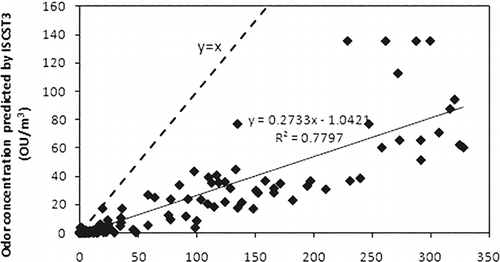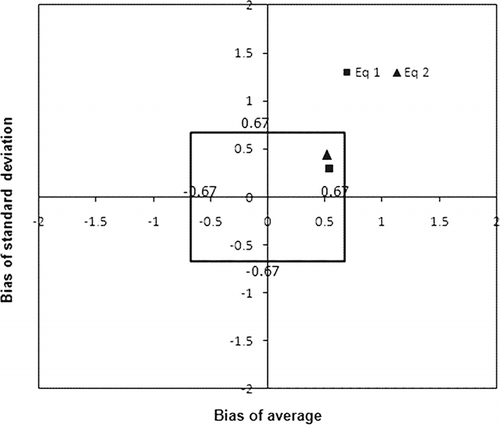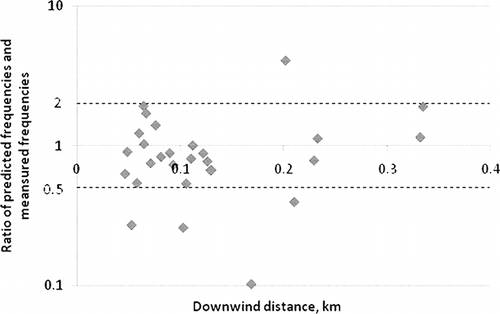ABSTRACT
A livestock odor dispersion model (LODM) was developed to predict odor concentration and odor frequency using routine hourly meteorological data input. The odor concentrations predicted by the LODM were compared with the results obtained from other commercial models (Industrial Source Complex Short-Term model, version 3, CALPUFF) to evaluate its appropriateness. Two sets of field odor plume measurement data were used to validate the model. The model-predicted mean odor concentrations and odor frequencies were compared with those measured. Results show that this model has good performance for predicting odor concentrations and odor frequencies.
This study provides an evaluation and validation for a newly developed LODM. Two sets of field odor plume measurement data were used. Agreement fractional bias values were applied to compare modeled predicted odor intensities and measured intensities. Fac2 (the percentage of the predictions within a factor of 2 of the observed values) and defined Ran0.1 and Ran0.2 values (the percentage of the predictions within a range of ±0.2 and ±0.1, respectively, of the observed values) were used to validate the model performance of predicting odor frequency.
INTRODUCTION
A livestock odor dispersion model (LODM) was developed specifically for livestock odor dispersion.Citation1 It has the ability to consider short time odor fluctuations and thus can predict subhour odor frequency, which is achieved by a weighted odor-exceeding half-width method. Pasquill–Gifford and Hogstrŏm dispersion parameters were applied in the model. In this paper, field plume measurement data (data from the University of Manitoba and University of Minnesota) were used to evaluate and validate LODM. Specifically, field-measured odor intensities were used to evaluate the LODM-predicted odor intensities and odor frequencies. Model-predicted odor concentrations based on part of the field-measured emission rate data and meteorological data from the University of Manitoba were also compared with those from the Industrial Source Complex Short-Term model, version 3 (ISCST3) and CALPUFF commercial air dispersion models.
DATA FROM THE UNIVERSITY OF MANITOBACitation2
Site Description and Odor Emission Rates
Trained odor sniffers were used to make odor plume measurements around two swine farms (A and B) located in southern Manitoba. The farms were 3000-sow farrowing operations with identical mechanically ventilated barns. The major difference between the two farms was that farm A had an open, single-cell earthen manure storage (EMS), whereas farm B had a two-cell EMS equipped with negative pressure synthetic covers. The surroundings of the two farms were similar—mostly flat cropland and the roughness length was assumed to be 0.1 m. Odor emission rate was measured during the period of each odor plume measurement.Citation2 The summary of odor emission rates from the measurement conducted during the odor plume measurement periods are given in .
Table 1. Odor emission rates of the farms in Manitoba.Citation2
Downwind Odor Plume Measurement
Fifteen human odor sniffers were selected and trained for conducting field odor measurements.Citation3 Standard reference 1-butanol samples were used to calibrate the sniffers' noses before they left for the field for each session. A base point was determined by geographical (longitude and latitude) readings from a global positioning system (GPS). It was selected on the edge of the farm. According to the measured wind direction, 15 sniffers were assigned to a three-row grid of 100, 500, and 1000 m downwind from the base point with the assistance of GPS units (GPS 45, Garmin International).
Every sniffer followed a central coordinator's instructions to sniff. During each 10-min measurement session, the sniffers put on a carbon-filtered air mask to rest his/her nose and sniffed the odor for 10 sec and then recorded the odor intensity and odor description. At the end of each session, each sniffer had recorded 61 observations. Normally three measurement sessions were carried out within 1 hr, with a 10-min break between sessions.Citation4
One hundred and twenty-nine field sessions were conducted around the two farms. Only 100 sessions conducted in daytime were used in this study because of insufficient data to determine the stability classes during nighttime. Weather data including solar radiation, temperature, relative humidity (RH), and wind speed and direction were taken every minute 5 min before and during the plume measurement period by an on-site weather station (WatchDog model 550, Spectrum Technologies Inc.). The weather station was placed 2 m above the ground to collect weather information during each session. During the used sessions, the solar radiation varied from 6 to 1252.9 W/m2, the ambient temperature ranged from 13.3 to 31.2 °C, and the wind speed was from 0 to 8.5 m/sec.
Model Configuration
The mean odor concentrations predicted by the LODM were compared with those obtained from the CALPUFF and ISCST3 commercial models. Passquil–Gifford (P-G) and Hogstrǒm dispersion coefficient schemes were used in the LODM to calculate mean odor concentrations. For comparison, configurations of the three models are set up to be same or as close as possible; for example, all three models use the buoyancy-induced dispersion, no exponential decay for the rural mode, and no dry/wet depletions. When P-G dispersion coefficients are applied in the LODM, the same default wind profile exponents and default vertical potential temperature gradient as the other two models were utilized. The barn was treated as a volume source, whereas the manure storage was considered to be an area source in the LODM. In ISCST3 and CALPUFF, barn and manure storage were processed as area sources. When comparisons were made among models, hourly meteorological data obtained by averaging the minute readings within three sessions in 1 hr was used, and 1-hr simulation was conducted. However, the average of the 10-min session's meteorological data was used to simulate the mean odor concentration and odor frequency using Hogstrŏm dispersion coefficients for validation of the LODM by field odor plume measurement. The average of wind direction follows the method of Mitsuta,Citation5 whereas the other parameters are averaged by taking their arithmetical means.
Relationship between Odor Intensity and Concentration
All of the air or odor dispersion models predict concentrations, whereas the odor intensities are measured in the field plume measurements. This results in a problem to be solved to validate odor dispersion models; that is, the odor detection threshold needs to be converted to the odor intensity to compare the field odor plume measurement to the result calculated by an air dispersion model and odor frequency.
Odor samples collected in Tedlar bags from swine farms and manure storages were measured in the Olfactometry Laboratory for odor intensity and concentration to establish the relationship between odor intensity and concentration. The conversion equations generated by Zhang et al.,Citation2 (Equationeq 1) and Feddes et al.Citation6 (Equationeq 2) were used to convert model-predicted odor concentration to odor intensity.
Results and Discussion
Comparison among LODM, ISCST3, and CALPUFF
The mean odor concentration values predicted by LODM were compared with those determined by ISCST3 and CALPUFF models to evaluate LODM. The R2, mean absolute error (MAE), and root mean square error (RMSE) were used to measure the consistency among the three models. MAE and RMSE are defined as follows (Equationeqs 3 and Equation4):
As shown in and , when P-G dispersion coefficients were used, the predicted mean concentrations by the LODM were highly correlated to those predicted by ISCST3 and CALPUFF, with R2 values of 0.860 and 0.969, respectively. Also, their absolute values were very close. The LODM-predicted mean odor concentrations were more consistent with the results yielded from the CALPUFF model than with those from the ISCST3. From the MAE and RMSE values (), it is seen that the differences among LODM, ISCST3, and CALPUFF are very small. These results demonstrate the validity of the algorithm used by the LODM to calculate the mean odor concentrations. It needs to be mentioned that in LODM the area source is processed by an imaginary point source method, which is different from the numerical integration method used in ISCST3 and CALPUFF models. The close mean odor concentration results may validate the use of the concept of the imaginary point source method for treating an area source.
Table 2. Comparisons in hourly mean odor concentrations among LODM, ISCST3, and CALPUFF
Figure 1. Comparisons of the predicted hourly mean odor concentrations by ISTSC3 and LODM (P-G) models.
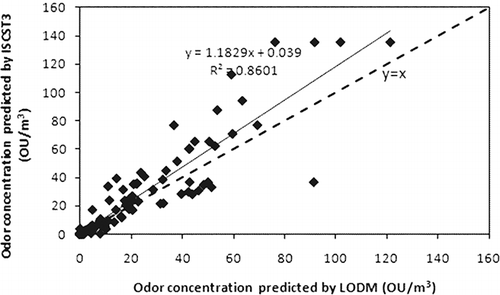
Figure 2. Comparisons of the hourly predicted mean odor concentrations by CALPUFF and LODM (P-G) models.
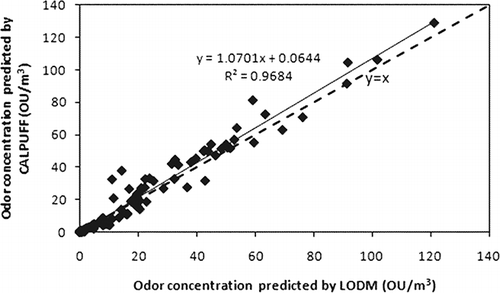
When Hogstrŏm dispersion coefficients were used, the predicted odor concentrations between LODM and other models were still highly correlated ( and ). However, the LODM-predicted odor mean concentrations were much larger than those predicted by the ISCST3 and CALPUFF models. According to MAE and RMSE, the differences between LODM and ISCST3 were similar to the difference between LODM and CALPUFF ().
Comparisons between Model-Predicted and Measured Mean Intensity
Within the 100 sessions, a total of 1444 pairs of intensity data were used to compare the predicted and measured mean odor intensities. From the scatter-plots of measured and modeled odor intensities using Equationeq 1 () and Equationeq 2 (), no obvious relationship between measured and modeled intensities can be found; however, it can be seen that LODM overpredicts the odor intensities. Therefore, the comparison was conducted by statistical parameters (e.g., R, normalized MAE [NMAE], normalized RMSE [NRMSE], agreements, and fractional bias [FB]).
Figure 5. Comparisons of the LODM predicted and measured 10-min mean odor intensities using Equationeq 1.
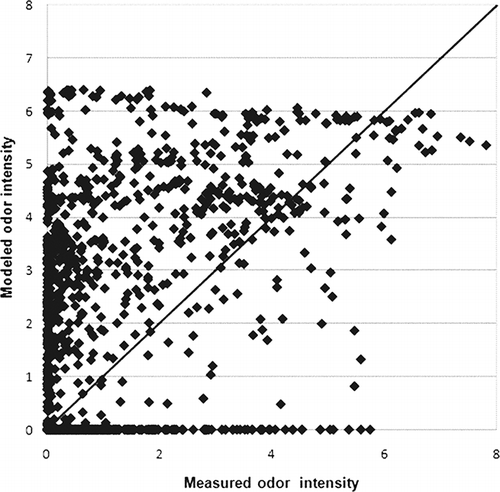
Figure 6. Comparisons of the LODM predicted and measured 10-min mean odor intensities using Equationeq 2.
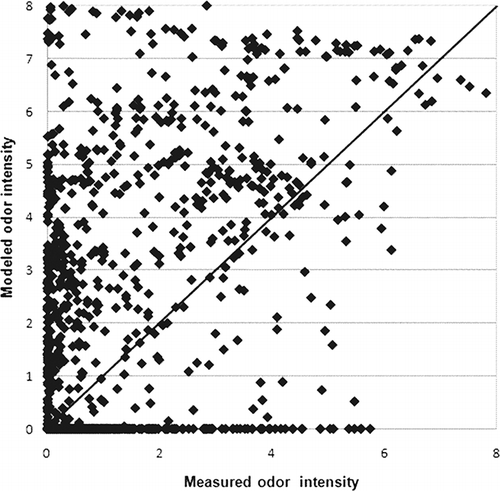
NMAE and NRMSE are defined as (Equationeqs 5 and Equation6)
Agreements are defined as the proportion of the predicted intensity values that matched with the experimentally measured ones. The predicted intensity is considered to match with measured intensity if it is within the range of ±0.5 of the measured odor intensity.Citation3 For example, if the predicted intensity is 1.3, then it is considered to be matched with measured intensity if measured intensity is between 0.8 and 1.8.
Statistical parameters (R, NMAE, NRMSE, and agreement) between predicted and measured mean odor intensities are listed in and using Equationeq 1 and Equationeq 2, respectively. The overall agreements between predicted and measured intensities are larger than 40%. At close distances (<250 m) the agreements are smaller than at longer distances, which shows that the model might have better performance at longer distances (600–1200 m). The result is consistent with that predicted by other commercial models with the same data.Citation3,Citation4 However, the R, NMAE, and NRMSE values show that the model performance is actually poorer at long distances than short distances. It can be concluded that the agreement cannot be used as the only index to assess the model performance at different distances. The better agreement at longer distances is probably due to the smaller values of odor intensity at longer distances. When the no-odor-detected periods are excluded, the overall agreements decrease to 30%, which is better than the results from other commercial models.Citation4 The model performs better at predicting non-zero odor intensities than overall intensities, including zero on the basis of the NMAE and NRMSE values. The overall agreement is enhanced from 41.1 to 46.2% when Equationeq 2 was used instead of Equationeq 1. The agreement for only considering non-zero odor periods also has a slight increase from 30 to 33%.
Table 3. Statistical comparison between LODM predicted and measured 10-min mean odor intensities using Equationeq 1
Table 4. Statistical comparison between LODM predicted and measured 10-min mean odor intensities using Equationeq 2
In addition to agreement, FB is also used to evaluate the performance of the model. The general expression for the FB is given by (Equationeq 7)Citation7
shows the FB values of average and standard deviation of the model regarding mean odor intensity when using Equationeqs 1 and Equation2. The values of average and standard deviation were 0.53 and 0.29 when using Equationeq 1, whereas they were 0.52 and 0.44 for Equationeq 2. All of these values are larger than zero and smaller than 0.67, which shows that the model had relatively good performance and slightly overpredicted the mean odor intensities.
Comparisons between the Model-Predicted and the Measured Odor Frequency
Odor frequency is defined as the percentage of time that the odor exceeds a certain level during a given time period. The odor frequency of 1 odor unit (OU)/m3 for each 10-min session was estimated by LODM. In detail, the frequency of odor concentration that equals to or exceeds 1 OU/m3 during each 10-min session was estimated by LODM with input of 10-min average meteorological data. The observed frequency of odor occurrences (observed intensity > 0) of each 10-min session was calculated from the measured intensity data. In total, 1444 pairs of data were used to compare the predicted odor frequency and observed frequency with the aid of Fac2 and FB. Fac2 is defined as the percentage of the predictions within a factor of 2 of the observed values.Citation7 It gives an indication of how many predictions are within a factor of 2 of the observed values. To further examine the model-predicted odor frequencies and measured odor frequencies, another two parameters named Ran0.2 and Ran0.1 are defined as the percentage of the predictions within a range of ±0.2 and ±0.1, respectively, of the observed values.
From , the overall Fac2 value was 37%. This means at least 37% of the predicted frequencies were within a factor of 2 of the observed odor frequency. At relatively closer (<200 m) and longer distances (600–1200 m), the Fac2 value was higher than the value at the middle distance (250–600 m). The overall Ran0.2 and Ran0.1 values were 50.9 and 37.6%, respectively, which means that approximately 50% of the LODM-predicted odor frequencies were within a range of ±0.2 of the observed odor frequencies and approximately 37% were within a range of ±0.1 of the observed odor frequencies. With an increase in the downwind distance, the Ran0.2 and Ran0.1 values did increase. At longer distances (600–1200 m), 77.4 and 66.2% of model-predicted odor frequencies were within a range of ±0.2 and ±0.1, respectively, of the observed odor frequencies. The increasing Ran0.2 and Ran0.1 values are probably caused by the decreasing value of the odor frequency at relatively long distances. When zero-odor periods were excluded, there were still 37.9 and 22.1% of model-predicted odor frequencies within a range of ±0.2 and ±0.1, respectively, of the observed odor frequencies. The FB value was −0.67, which means that the model underpredicted the odor frequency by an average of a factor of 2.
Table 5. FAC2, Ran0.2, and Ran0.1 of the model-predicted odor frequency within 10-min sessions for data from Manitoba
DATA FROM THE UNIVERSITY OF MINNESOTACitation8
Site Description and Odor Emission Rates
A total of 28 farm sites were measured in Minnesota, which covered most of the animal species.Citation8 The odor plume measurements were conducted for animal barns or for EMS. The surroundings of the farms were all considered as mostly flat cropland free of obstacles. Odor emission rates were measured during the period of each odor plume measurement.Citation8 The summary of average odor concentrations and emission rates from the measurements selected are given in .
Table 6. Measured odor emission rates for different farms in Minnesota
Downwind Odor Plume Measurement
According to the experiment descriptions in Zhu et al.,Citation8 seven trained human sniffers were sent to the field to conduct field odor plume measurements. Locations of the sniffers were determined based on the estimated center line of odor plume. Human sniffer scores were taken every 10 sec for a period of 10 min. In this study, a total of 30 sessions of data taken over 8 different days in 1998 were obtained from the University of Minnesota. For each of the days, two or three sessions of data were taken in the morning and afternoons, with each session at a different short distance (25–300 m) down-wind of the odor source.
A portable weather station was set up 2 m above the ground to record weather information, including wind speed and direction, solar radiation, temperature, recording time, and RH. The meteorological data were recorded every 10 sec. During the 30 sessions, the solar radiation varied from 4.2 to 902 W/m2, the ambient temperature ranged from 11.2 to 27.7 °C, and the wind speed was 1–6 m/sec.
Relationship between Odor Concentration and Odor Intensity
The relationships between odor intensity on a 0-to-5 scale and concentration (Equationeq 8) for swine odor from Guo et al.Citation9 were used when comparing the model-predicted odor intensities to the observed odor intensities.
Results
Because field odor intensity was measured in a 10-sec interval within a 10-min session, the average of the measured odor intensity within one session was considered as the 1-hr average. The averaged 10-min-session meteorological data were obtained and inputted to the LODM as 1-hr averages to predict the odor concentration and odor frequency using Hogstrŏm dispersion coefficients. The EMS were treated as area sources, whereas the animal barns were treated as volume sources. Because only the center line of the nasal rangers' layout in the data of 1998 could be ratified, there were 30 pairs of data points that were used to make the comparisons. All of the measurements were conducted within the downwind distances of 25 and 300 m.
Comparisons between the Model-Predicted and Measured Mean Odor Intensity
The agreement and FB that were defined in the previous section were used to compare the model-predicted mean intensity to the measured mean intensity. Results show that approximately 34% of the model-predicted intensity was within the range of ±0.5 of the measured odor intensity. In this case, only receptors at the plume center line were considered. All of the measured odor intensities were non-zeroes, so the agreement obtained is consistent with the results of data from the University of Manitoba. The FB value of the average intensity is −0.5, which also indicates that the model underpredicted the mean odor intensity.
Comparisons between the Model-Predicted and Measured Frequency
The ratios of predicted and measured odor frequencies are shown in . It shows that most of the model-predicted odor frequencies were within a factor of 2 of the observed odor frequencies. The Fac2, Ran0.2, and Ran0.1 values of the model-predicted odor frequency are listed in . The Fac2 value is 79.3%, which indicates that approximately 80% of the modeled odor frequencies were in a factor of 2 of the observed frequencies. The Ran0.2 and Ran 0.1 values were 44.8 and 31%, respectively. Approximately 45 and 30% of the model-predicted odor frequencies were within the range of ±0.2 and ±0.1, respectively, of the observed odor frequencies.
Table 7. FAC2, Ran0.2, and Ran0.1 values of the model-predicted odor frequency within 10-min sessions for data from Minnesota
DISCUSSION
There are many possible reasons for the discrepancies between the predicted and measured mean odor intensity and odor frequency. Firstly, the LODM was developed with many assumptions, as were all of the other models. The model assumes that odor can be treated as a gas and that it undergoes no chemical or physical changes during its transportation in the atmosphere. The ground level was treated as completely reflected without odor absorption or deposition. The model is based on steady-state meteorological conditions; however, in most of the 10-min sessions, the wind directions shifted frequently. The short time average vertical dispersion coefficients are functions of plume height, which varies vertically with the plume fluctuations. However, in this model they are assumed to be the same as the vertical dispersion parameters at the mean plume height. All of these assumptions may lower the accuracy of the model predictions.
Secondly, constant odor emission rates were used in the model simulations. However, diurnal variations of odor emission rate from swine farms can be signifi-cant.Citation10,Citation11 The measurement of odor concentration used to obtain the odor emission rate and the field odor plume intensity were conducted by human assessors with limits of precisionCitation12,Citation13 (the uncertainty could be up to a factor of 1–2).
Thirdly, the uncertainty of the conversion equation of odor concentration and odor intensity may be another very important effect factor of the model performance. Three different odor intensity and concentration conversion equations from different researchers gave widely varied concentrations, especially at the low intensity levels.Citation4 When analyzing the data from the University of Minnesota, conversion Equationeqs 1 and Equation2 were applied to explore the possible effect of different conversion equations. When these equations were used, the agreements of mean odor intensities were approximately 10%, which are much lower than those obtained using Equationeq 8.
CONCLUSIONS
After comparing the mean concentrations predicted by LODM, ISCST3, and CALPUFF and comparing LODM-predicted concentration (intensity) and odor frequency between model-predicted and field-measured data, the following conclusions can be drawn:
| 1. | LODM can predict similar mean odor concentrations as ISCST3 and CALPUFF when using P-G dispersion parameters. When Hogstrŏm dispersion parameters were used, the LODM-predicted odor concentrations were larger than those from the ISCST3 and CALPUFF models. | ||||
| 2. | Agreements between LODM-predicted mean odor intensities and field-measured odor intensities were high and they were higher at longer distances than at close range. | ||||
| 3. | LODM predicted odor frequency fairly well. The model underpredicted the odor frequency. Several possible reasons, especially the effect of the conversion equation between odor intensity and odor concentration, may have contributed to the discrepancy between modeled and observed results. | ||||
ACKNOWLEDGMENTS
This study was financially supported by the Natural Sciences and Engineering Research Council of Canada and by the University of Saskatchewan. The authors acknowledge the University of Manitoba and the University of Minnesota for providing odor field plume measurement data.
REFERENCES
- Yu , Z.M. , Guo , H.Q. and Laguë , C. 2011 . Development of a Livestock Odor Dispersion Model: Part I. Model Theory and Development . Journal of the Air & Waste Management Association , 61 : 269 – 276 . doi: 10.3155/1047-3289.61.3.269
- Zhang , Q. , Zhou , X.J. , Guo , H.Q. , Li , Y.X. and Cicek , N. 2005 . Odor and Greenhouse Gas Emissions from Hog Operations , Winnipeg, Manitoba , , Canada : Manitoba Livestock Manure Management Initiative, Inc . Project MLMMI 03-HERS-01
- Zhou , X.J. , Zhang , Q. , Guo , H. and Li , Y.X. Evaluation of Air Dispersion Models for Livestock Odor Application. Presented at the Canadian Society of Agricultural Engineering(CSAE)/Société Canadienne de Génie Rural (SCGR) 2005 Meeting . Paper No. 05–026 . 2005 . CSAE/SCGR: Winnipeg, Manitoba, Canada
- Xing , Y. , Guo , H. , Feddes , J. and Shewchuck , S. Evaluation of Air Dispersion Models Using Swine Odor Plume Measurement Data; Canadian Society of Bioengineers (CSBE) . Paper No. 06-172 . 2006 . CSBE: Winnipeg, Manitoba, Canada
- 2000 . Meteorological Monitoring Guidance for Regulatory Modeling Applications , Research Triangle Park , NC : U.S. Environmental Protection Agency .
- Feddes , J. 2006 . Development of Odor Monitoring Procedures for Alberta Livestock Operations: Measuring Odor with Confidence , Edmonton, Alberta , , Canada : Alberta Livestock Industry Development Fund; Alberta Agricultural Research Institute .
- Chang , J.C. and Hanna , S.R. 2004 . Air Quality Model Performance Evaluation . Meteorol. Atmos. Phys. , 87 : 167 – 196 .
- Zhu , J. , Jacobson , L.D. , Schmidt , D.R. and Nicolai , R. 2000 . Evaluation of INPUFF-2 Model for Predicting Downwind Odors from Animal Production Facilities . Appl. Eng. Agric. , 16 : 159 – 164 .
- Guo , H. , Jacobson , L.D. , Schmidt , D.R. and Nicolai , R.E. 2001 . Calibrating IN-PUFF-2 Model by Resident-Panelists for Long-Distance Odor Dispersion from Animal Production Sites . Appl. Eng. Agric. , 17 : 859 – 868 .
- Guo , H. , Dehod , W. , Agnew , J. , Feddes , J. , Lague , C. and Pang , S. 2007 . Daytime Odor Emission Variations from Various Swine Barns . Trans. ASABE. , 50 : 1365 – 1372 .
- Wang , Y. and Guo , H. Diurnal Odor and Gas Emission Rates from Different Swine Buildings under Two Climatic Conditions; American Society of Agricultural and Biological Engineers (ASABE) . Paper No. 074132 . 2007 . ASABE: St. Joseph, MI
- Air Quality-Determination of Odour Concentration by Dynamic Olfactometry; EN13725:2003; Committee for European Normalization: Brussels, Belgium. 2003.
- 1999 . Standard Practice for Referencing Suprathreshold Odor Intensity , Philadelphia , PA : American Society of Testing and Materials . ASTM. E544-99
